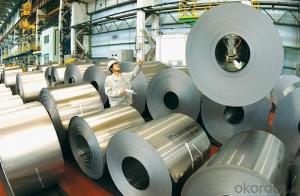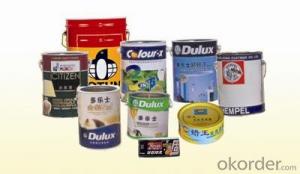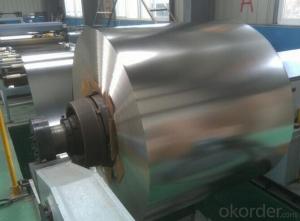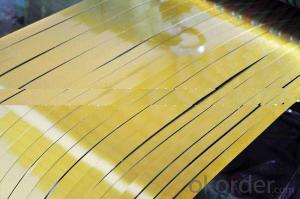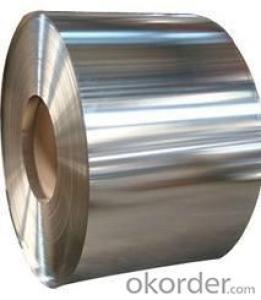MR Tinplate JIS G3303 For Industrial Usage
- Loading Port:
- Tianjin
- Payment Terms:
- TT OR LC
- Min Order Qty:
- 25 m.t.
- Supply Capability:
- 40000 m.t./month
OKorder Service Pledge
OKorder Financial Service
You Might Also Like
Item specifice
1.Usage
Tinplate is widely used for making all types of containers, containing industrial usage such as paint can, oil can, aerosol cans etc., and food cans like milk powder cans, tomato paste can, dry food cans etc.
2. Quality
As a state owned company and a large tinplate supplier in China, our tinplate quality ranks 1st level in China, similar to Bao Steel, Posco etc.
3. CA Line Production Range
Temper | Thickness(mm) | Width(mm) | Length(mm) |
T3CA | 0.19~0.20 | 800~900 | 520~1068 |
0.21~0.25 | 800~950 | ||
0.26~0.45 | 800~1050 | ||
T4CA | 0.17~0.20 | 800~950 | |
0.20~0.45 | 800~1050 | ||
T5CA | 0.17~0.20 | 800~950 | |
0.20~0.28 | 800~1050 |
4. Our factory photo & equipments

6. FAQ
a. What’s the price difference between SPCC & MR?
Our MR is about usd 15~20/mt higher than SPCC; b. What’s the difference between SPCC & MR
They have difference element content, MR is better than SPCC in anti-rust and deep drawing.
Steel | C | Si | Mn | P | S | Cu | Others |
MR | ≤0.09 | ≤0.03 | ≤0.35 | ≤0.02 | ≤0.025 | ≤0.1 | ≤0.35 |
SPCC | ≤0.12 | ≤0.5 | ≤0.035 | ≤0.025 |
c. What production standards you accept?
We could accept production standards upon our customer request, such as JISG 3303, DIN EN10202, GB/T2520 etc. Our tinplate could meet these standards.
d. If we want to place order, is there any requirement about the booking time?
We need to purchase raw material in advance. Around date 20 per month our production plan will be finalized. So it’s better if customer could place order before date 20 per month, otherwise the delivery time will delay one month.
- Q:Can tinplate be used in extreme temperatures?
- Yes, tinplate can be used in extreme temperatures. It is known for its excellent resistance to high and low temperatures, making it suitable for various applications in extreme environments.
- Q:How does tinplate perform in terms of resistance to chemical agents?
- Tinplate is known for its excellent resistance to chemical agents. It has a protective tin coating that provides a barrier against corrosive substances and prevents them from interacting with the underlying metal. This resistance makes tinplate suitable for packaging various products, including food and beverages, as it helps maintain the integrity and safety of the contents.
- Q:Tin can bake oven electrical electromagnetic induction principle
- If the bottle seal, then you might be in the vacuum pressure in the bottle the bottle burst, even if there is no heating effect, pressure by the iron pot after heating of the electromagnetic wave will be more and more, the bottle will burst.
- Q:Can tinplate packaging be used for pet food products?
- Yes, tinplate packaging can be used for pet food products. Tinplate is a commonly used material for packaging due to its durability, resistance to corrosion, and ability to maintain the freshness and quality of food products. It provides a secure and protective barrier against external elements, making it suitable for pet food products as well.
- Q:What is the cost of tinplate compared to other packaging materials?
- The cost of tinplate is generally higher compared to other packaging materials such as plastic or cardboard.
- Q:Can tinplate be used for packaging liquid products?
- Yes, tinplate can be used for packaging liquid products. Tinplate is highly resistant to corrosion and can effectively protect the contents from external elements. It is commonly used for packaging liquid products such as beverages, oils, and chemicals due to its durability and ability to maintain product integrity.
- Q:What are the main advantages of using tinplate for electrical enclosures?
- The main advantages of using tinplate for electrical enclosures include its high strength and durability, excellent corrosion resistance, and good electrical conductivity. Tinplate is also lightweight and easy to form, making it a cost-effective choice for manufacturing enclosures. Additionally, tinplate is recyclable, making it an environmentally friendly option for electrical applications.
- Q:What are the main differences between tinplate and tinplate laminates?
- Tinplate and tinplate laminates are similar in that they both consist of a thin layer of tin applied to a base material, typically steel. However, the main difference lies in their composition and properties. Tinplate is a single-layer material with a tin coating on one or both sides, providing excellent corrosion resistance and a shiny appearance. On the other hand, tinplate laminates are composed of multiple layers, with tin coatings sandwiched between layers of other materials, such as paper, plastic, or aluminum. This combination enhances the product's functionality, offering benefits like improved barrier properties, additional strength, and enhanced printability. Therefore, while tinplate is suitable for various packaging applications, tinplate laminates offer a wider range of options and versatility.
- Q:How does tinplate packaging contribute to product portion control?
- Tinplate packaging contributes to product portion control by providing a durable and versatile material that can be easily shaped and sealed. This allows manufacturers to create smaller, individual-sized containers, which helps consumers monitor and limit their consumption. Additionally, tinplate packaging often includes clear labeling and measurement indicators, making it easier for consumers to accurately gauge their desired portion sizes.
- Q:What are the different methods of sealing tinplate containers?
- There are several methods of sealing tinplate containers including soldering, crimping, welding, and using adhesive or pressure-sensitive seals.
1. Manufacturer Overview |
|
|---|---|
| Location | |
| Year Established | |
| Annual Output Value | |
| Main Markets | |
| Company Certifications | |
2. Manufacturer Certificates |
|
|---|---|
| a) Certification Name | |
| Range | |
| Reference | |
| Validity Period | |
3. Manufacturer Capability |
|
|---|---|
| a)Trade Capacity | |
| Nearest Port | |
| Export Percentage | |
| No.of Employees in Trade Department | |
| Language Spoken: | |
| b)Factory Information | |
| Factory Size: | |
| No. of Production Lines | |
| Contract Manufacturing | |
| Product Price Range | |
Send your message to us
MR Tinplate JIS G3303 For Industrial Usage
- Loading Port:
- Tianjin
- Payment Terms:
- TT OR LC
- Min Order Qty:
- 25 m.t.
- Supply Capability:
- 40000 m.t./month
OKorder Service Pledge
OKorder Financial Service
Similar products
New products
Hot products
Hot Searches
Related keywords
